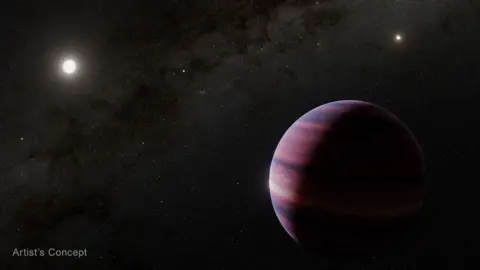Science correspondent
 NASA, ESA, CSA, STScI, R. Hurt (Caltech/IPAC)
NASA, ESA, CSA, STScI, R. Hurt (Caltech/IPAC)Scientists have found strong evidence of a giant gas planet in the nearest star system to our own.
At four-and-a-half light years away, the lifeless planet would be a close neighbour to Earth in astronomical terms and could have moons that sustain life.
The signs were found in the star system Alpha Centauri by the powerful James Webb Space Telescope.
The potential planet was detected last year, but it had disappeared in follow-up observations. Astronomers must now look again to prove it definitely exists.
Scientists are particularly excited about this discovery because of the similarities between the exoplanet’s star and our Sun.
“Four years is a long way but in galaxy terms, it’s very close – it’s in our neighbourhood,” said Dr Carly Howett, associate professor of space instrumentation at the University of Oxford.
“It is around a star that is Sun-like and about the same temperature and brightness. That’s really important if we want to think about habitable worlds,” she added.
The planet would be similar to our solar system’s gas giants, Saturn and Jupiter, and would be enveloped in a thick gas cloud.
That means it could not support life itself, but it could have moons that are habitable.
Jupiter and some other planets in our solar system have icy moons, which researchers believe could support life.
Scientists are currently investigating that possibility on missions called Europa Clipper and Juice.
But those planets are far away from our life-giving Sun. The potential “new” planet is comparatively close to its star.
 Getty Images
Getty ImagesThe signs were found in direct imaging by the James Webb Space Telescope, which is the closest thing scientists have to taking photographs of distant objects.
“These are incredibly challenging observations to make, even with the world’s most powerful space telescope, because these stars are so bright, close, and move across the sky quickly,” said Charles Beichman from Nasa’s Jet Propulsion Laboratory and co-first author of the new discoveries.
Those stars create huge amounts of bright light that can block out nearby objects.
That could be why the planet was detected once, in August 2024, but then seemingly disappeared when scientists looked for it again.
“Probably the planet was either behind the star or too close to be able to see it. You need an element of luck,” said Dr Howett.
Astronomers will now look for more signs of the planet. They hope to use a new Nasa telescope – the Grace Roman Space Telescope – which is due to start operating in 2027.
Future observations by the James Webb Space Telescope should also be able to tell us what the planet is made up of, using something called spectral imaging.
That will build up a more detailed picture of what it looks like, and how habitable any orbiting Moons could be.
[source_link



